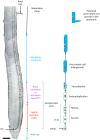Spatial Regulation of Root Growth: Placing the Plant TOR Pathway in a Developmental Perspective
- PMID: 26295391
- PMCID: PMC4581319
- DOI: 10.3390/ijms160819671
Spatial Regulation of Root Growth: Placing the Plant TOR Pathway in a Developmental Perspective
Abstract
Plant cells contain specialized structures, such as a cell wall and a large vacuole, which play a major role in cell growth. Roots follow an organized pattern of development, making them the organs of choice for studying the spatio-temporal regulation of cell proliferation and growth in plants. During root growth, cells originate from the initials surrounding the quiescent center, proliferate in the division zone of the meristem, and then increase in length in the elongation zone, reaching their final size and differentiation stage in the mature zone. Phytohormones, especially auxins and cytokinins, control the dynamic balance between cell division and differentiation and therefore organ size. Plant growth is also regulated by metabolites and nutrients, such as the sugars produced by photosynthesis or nitrate assimilated from the soil. Recent literature has shown that the conserved eukaryotic TOR (target of rapamycin) kinase pathway plays an important role in orchestrating plant growth. We will summarize how the regulation of cell proliferation and cell expansion by phytohormones are at the heart of root growth and then discuss recent data indicating that the TOR pathway integrates hormonal and nutritive signals to orchestrate root growth.
Keywords: TOR (target of rapamycin); auxin; cell growth; cytokinin; elongation; environment; meristem; plant; proliferation; root.
Figures






References
Publication types
MeSH terms
Substances
LinkOut - more resources
Full Text Sources
Other Literature Sources

